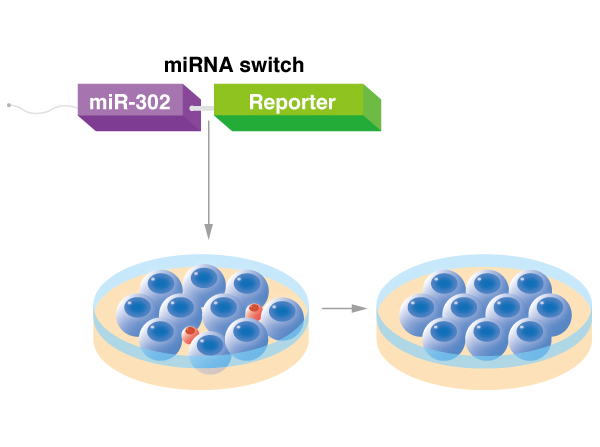
Research Activities
Research Activities
Publications
September 09, 2016
RNA detects and eliminates undifferentiated cells

miR-302 switches can identify and remove even a tiny number of potentially cancerous cells (red) from a cell population for therapy
Pluripotent stem cells (PSCs) allow scientists to create any number of cells of any types for regenerative medicine. However, the transformation is not 100%, resulting in residual PSCs and other undifferentiated cells. Because these residual cells proliferate, they risk creating tumors, which means they must be removed before the cell therapy is applied to the patient. Typically, removal involves the use of antibodies that bind to surface receptors on the PSCs. However, antibodies are not perfect at purifying the target cells. According to Professor Hirohide Saito of CiRA, "Alternative strategies for cell purification are important to facilitate some cell therapies."
For one strategy, the Saito lab is seeking unique signatures from inside the cell. "We are separating cells by micro RNA (miRNA), not surface receptors," explains Dr. Callum Parr, a researcher in the Saito laboratory and first author of a new study in Scientific Reports that describes miRNA-based technology.
In a previous publication, the group had reported miRNA switches, a biotechnology that turns a gene on or off depending on the miRNA found inside the cell. The body has thousands of miRNAs, but one in particular, miR-302, is especially associated with proliferation. "Undifferentiated cells specifically express miR-302 and as they differentiate they lose this expression," said Parr.
The paper shows that miR-302 switches are more sensitive to the presence of undifferentiated cells in a heterogeneous cell population than methods that depend on antibodies, and could identify undifferentiated cells that constituted only 0.05% of the cell population. Further, the researchers used their miRNA switch to effectively separate the undifferentiated cells from the rest of the population. Based on this finding, Parr believes, "We can control cell survival using this miR-302 switch to setup a gene circuit that will automatically kill undifferentiated cells. This is a major advantage because with previous methods we have to sort the cells out using expensive equipment in a process that is both time-consuming and damaging to live-cells."
Paper Details
- Journal: Scientific Reports
- Title: MicroRNA-302 switch to identify and eliminate undifferentiated human pluripotent stem cells
- Authors: Callum J C Parr1, Shota Katayama1, Kenji Miki1, Yi Kuang1, Yoshinori Yoshida1, Asuka Morizane2, Jun Takahashi2, Shinya Yamanaka1,3, Hirohide Saito1
- Author Affiliations:
- Department of Life Science Frontiers, Center for iPS Cell Research and Application (CiRA), Kyoto University, Kyoto, Japan.
- Department of Clinical Application, Center for iPS Cell Research and Application (CiRA), Kyoto University, Kyoto, Japan.
- Gladstone Institute of Cardiovascular Disease, San Francisco, CA 94158, USA.






















